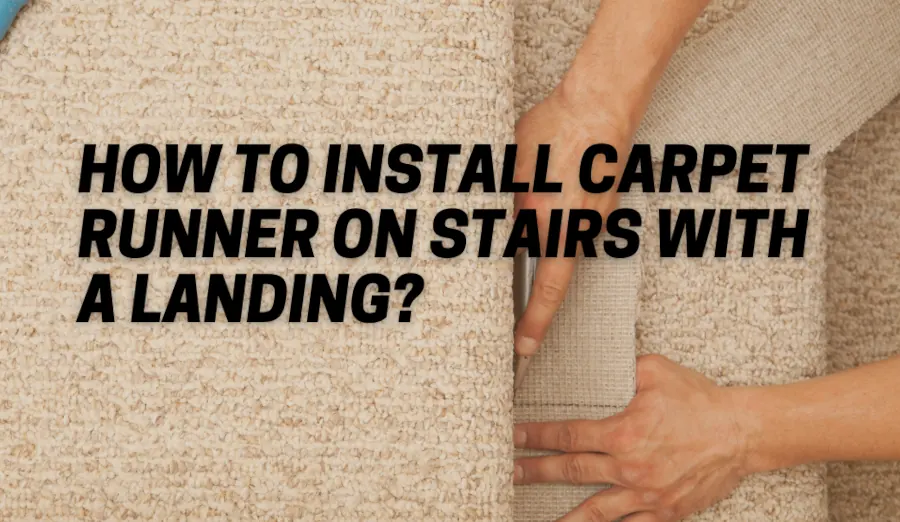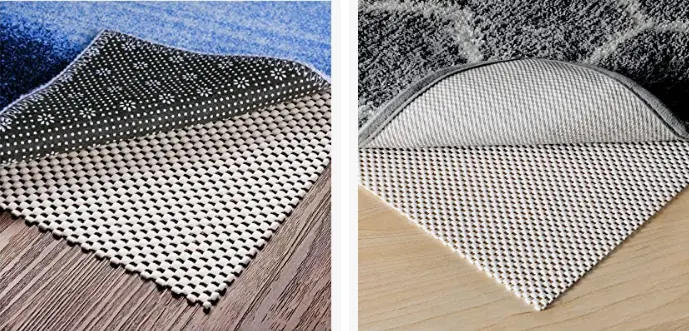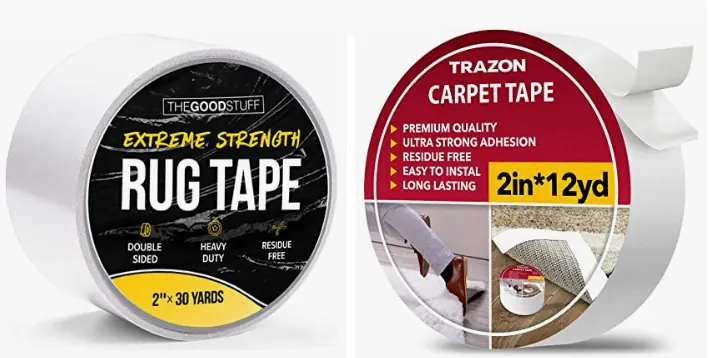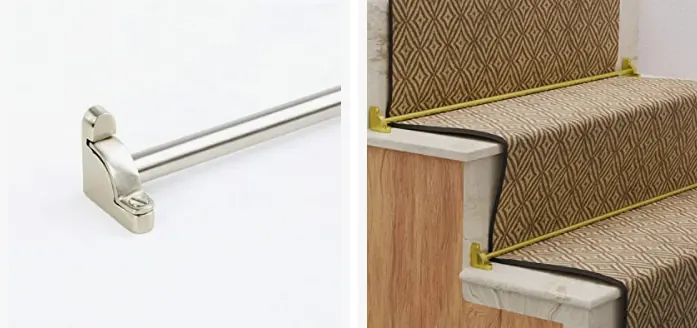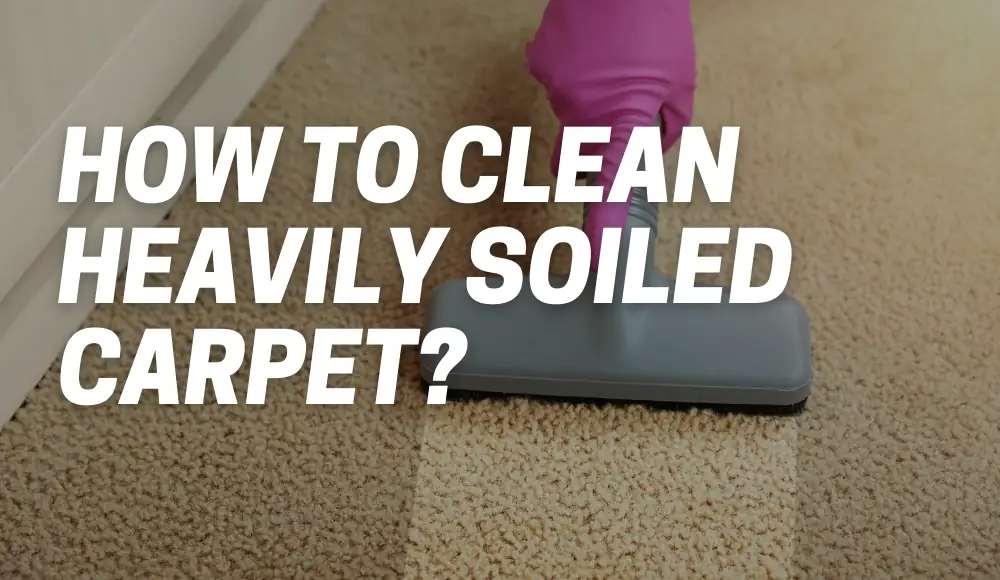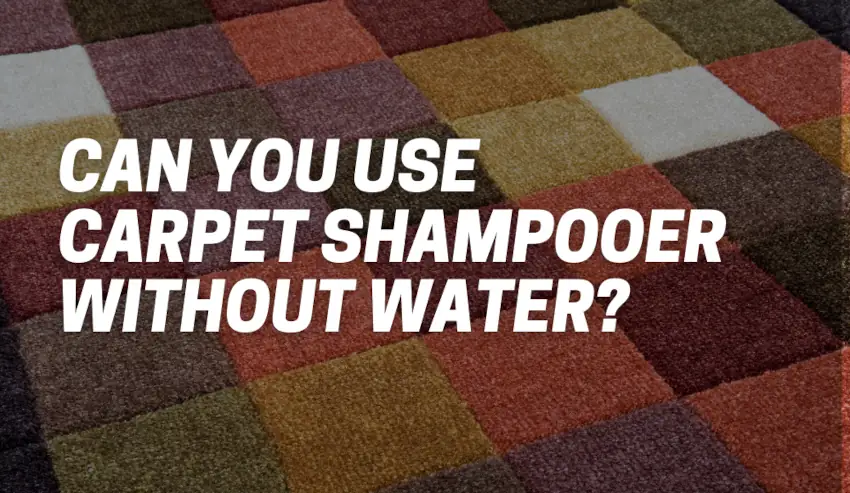If you’re considering adding a touch of elegance and safety to your staircase, you’ve probably come across the idea of installing a stair runner carpet. A stair runner carpet not only adds visual appeal but also provides traction and reduces noise. In this guide, we will explore the installation process of how to install carpet runner on stairs with a landing.
We’ll answer common questions such as whether you should put a carpet runner on the landing, where the stair runner meets the landing, what to put under a stair runner, how to install it on a stair landing, and how to secure a rug runner on stairs.
Do You Put Carpet Runner on Landing?
First things first.
The decision to put a carpet runner on a landing depends on your personal preference and the overall aesthetics you want to achieve.
Some homeowners choose to extend the carpet runner onto the landing, while others prefer to have the landing exposed. Both options have their pros and cons.
If you decide to put a carpet runner on the landing, it can create a cohesive look, providing a smooth transition between the stairs and the landing area. This can give your staircase a more unified and elegant appearance.
Additionally, a carpet runner on the landing can help protect the underlying flooring from wear and tear.
On the other hand, leaving the landing exposed without a carpet runner allows you to showcase the natural beauty of the flooring material. It can also make the space appear larger and more open.
Ultimately, the choice between a carpet runner (stair carpet) on the landing or leaving it uncovered is subjective and should align with your personal style and preferences.
Should a Stair Runner Continue to a Landing?
When deciding whether a stair runner should continue to a landing, it’s important to consider the visual flow and functionality of the space.
In many cases, continuing the stair runner onto the landing can create a harmonious and seamless look.
However, there are a few factors to keep in mind.
One consideration is the size and shape of the landing. If the landing is small, adding a carpet runner may overpower the space and make it feel cramped. In such cases, it might be better to leave the landing uncovered or use a different flooring material that complements the runner on the stairs.
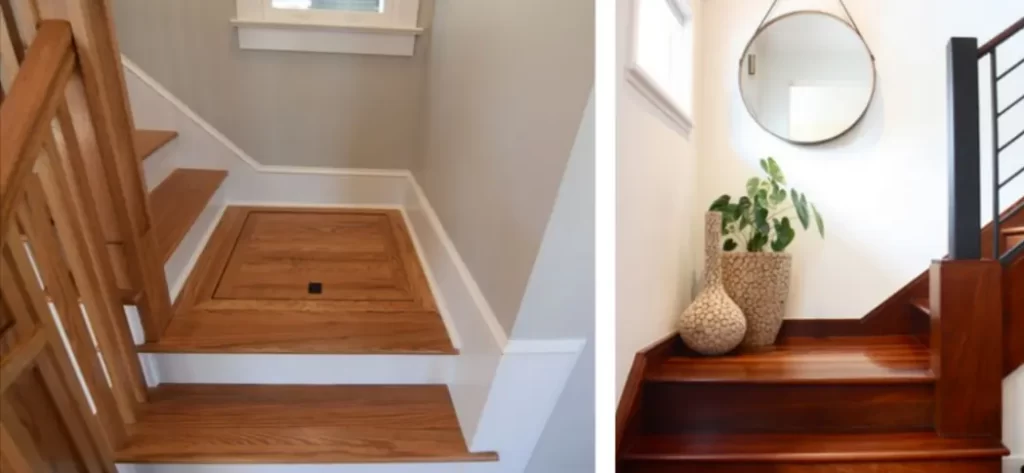
Another factor to consider is the overall design theme of your home. If you have a cohesive design scheme throughout your house, extending the stair runner to the landing can contribute to a sense of continuity.
However, if each floor has a distinct style or flooring choice, it might be more appropriate to have the landing reflect that uniqueness.
Ultimately, the decision to continue a stair runner to a landing should be based on your personal taste, the size and shape of the landing, and the overall design of your home.
Where Stair Runner Meets Landing?
The point where the stair runner meets the landing is a crucial detail in the installation process.
This transition area should be seamless and well-executed to ensure a professional and polished look.
There are a few different techniques to achieve a smooth junction between the runner and the landing.
- One popular method is to use a transition strip or molding. These strips are available in various materials and designs to match your staircase and landing decor. The transition strip is typically installed at the edge of the stair runner, covering any visible seams or rough edges. It provides a clean transition and prevents the carpet runner from fraying.
- Another technique is to fold the runner at the edge of the last step and tuck it neatly under the carpet on the landing. This method requires precise cutting and folding of the runner to create a seamless finish. It’s essential to use carpet adhesive or double-sided tape to secure the folded portion, ensuring it stays in place.
Regardless of the method you choose, taking care to create a smooth transition between the stair runner and the landing is essential for achieving a professional and visually appealing result.
What Do You Put Under a Stair Runner?
Do you need a pad under a stair runner?
To ensure the longevity and stability of your stair runner, it’s crucial to provide proper support and cushioning underneath.
Here are a few options for what you can put under a stair runner:
- Carpet Padding: Carpet padding provides additional comfort and support. It helps absorb impact and reduces noise. Choose a high-quality carpet padding that is specifically designed for use on stairs.
- Double-Sided Carpet Tape: Double-sided carpet tape is an adhesive strip that can be used to secure the stair runner to the steps. It helps prevent the runner from shifting or slipping, providing a safer and more stable surface.
- Stair Rods: Stair rods are decorative metal rods that can be installed across the width of the stair runner. They add a touch of elegance and also help hold the runner in place.
Carpet padding for under stair runner carpet
Double-sided carpet tape
Stair rods for carpet
By using a combination of these options, you can ensure that your stair runner is securely installed, providing both comfort and stability.
How Do You Install a Carpet Runner on a Stair Landing?
Installing a carpet runner on a stair landing requires careful preparation and precise execution.
Materials Needed
Before you start installing your carpet runner on stairs with a landing, you need to make sure that you have all the necessary materials and tools.
Here is a list of everything you’ll need for this project:
Materials
- Carpet runner: Make sure to measure the length and width of your stairs and landing accurately so that you purchase the correct amount.
- Tack strips: You will need enough tack strips to cover each step, landing, and any corners or turns.
- Staples or adhesive: Depending on your preference, either staples or adhesive will be needed to secure the runner onto each step.
- Padding: Carpet padding can help provide additional comfort while also protecting the carpet’s backing from damage.
- Carpenter’s square: This tool will be useful for measuring angles when cutting the carpet runner.
Tools
- Knee pads: Installing a carpet runner can be hard work, so make sure you protect your knees with knee pads.
- Staple gun or adhesive applicator: Whichever method of attachment chosen requires either a staple gun or adhesive applicator.
- Utility knife: A sharp utility knife is needed for cutting the carpet runner to fit around edges and corners.
- Measuring tape: To ensure accurate measurements are taken during installation.
- Hammer/nails/nail punch tool (optional): These tools are optional but may be needed if there are areas where tack strip cannot be used.
It’s important to have all these materials ready before beginning installation.
Otherwise, it could become frustrating when stopping midway through due to not having something essential for finishing this project promptly.
Here’s a step-by-step guide to help you through the process of installing the carpet runner on the landing:
- Measure and Cut: Measure the width and length of the landing area, allowing for a slight overhang. Cut the carpet runner to the appropriate size, ensuring it fits the landing accurately.
- Prepare the Landing: Clean the landing thoroughly and remove any existing flooring or debris. Ensure the surface is smooth and free of imperfections.
- Install Padding: If you’ve chosen to use carpet padding, cut it to fit the size of the landing. Secure it in place using carpet adhesive or double-sided tape, making sure it is smooth and wrinkle-free.
- Lay the Runner: Place the carpet runner over the landing, ensuring it is centered and aligned correctly. Smooth out any wrinkles or bubbles by pressing down firmly.
- Secure the Runner: Use double-sided carpet tape or adhesive to secure the edges of the runner to the landing. Make sure the tape is placed along the entire length of the runner’s edges, providing a secure hold.
- Finish the Edges: If necessary, use a transition strip or molding to cover the edges of the runner and create a smooth transition between the landing and the runner.
- Trim Excess: Trim any excess carpet runner using a sharp utility knife, ensuring clean and straight edges.
In the next video you can see the process of how to carpet stairs with a landing in real life:
How to Install Carpet Runner on Stairs with a Landing
—
How Do You Secure a Rug Runner on Stairs?
Securing a rug runner on stairs is essential to prevent accidents and ensure a safe environment.
Here’s a simple method to help you secure a rug runner on stairs:
- Measure and Cut: Measure the length of the stairs and the rug runner. Cut the runner to the appropriate size, allowing for a slight overhang on each step.
- Prepare the Stairs: Clean the stairs thoroughly and remove any debris or existing carpeting. Ensure the surface is smooth and free of protruding nails or staples.
- Install Padding and Runner: If using carpet padding, cut it to fit the size of each step. Attach the padding securely using carpet adhesive or double-sided tape. Lay the rug runner over the padding, ensuring it is centered and aligned correctly.
- Secure the Runner: Use double-sided carpet tape or adhesive to secure the edges of the runner to each step. Make sure the tape is placed along the entire length of the runner’s edges, providing a secure hold.
- Optional: Use Stair Rods: If desired, install stair rods across the width of the runner, following the manufacturer’s instructions. Stair rods add a decorative touch and provide additional stability.
By following these steps, you can ensure that your rug runner is firmly secured to the stairs, reducing the risk of slips and falls.
Maintenance
Preserving Your Investment
After investing time and money into installing a carpet runner on your stairs, it is essential to maintain it properly.
Maintaining your carpet runner will keep it looking like new for years to come. With regular cleaning, your carpet runner will maintain its color and texture, which will enhance the overall look of your home.
Cleanliness is Key
The first, and most crucial, step in maintaining your carpet runner is keeping it clean. Vacuuming weekly with a high-quality vacuum cleaner designed for stairs can help prevent dirt and debris from becoming embedded in the fibers of the carpet.
If you have pets or young children who are prone to spills, consider spot cleaning with a gentle detergent and water as needed.
Do not use harsh chemicals or abrasive cleaners as they can damage the fibers of the carpet over time.
Deep Cleaning Your Carpet Runner
Even with routine vacuuming and spot cleaning, deep cleaning your carpet runner periodically is necessary.
Depending on foot traffic levels and exposure to dirt and dust particles, deep cleaning should occur once every 12-18 months. You can hire professional cleaners or rent a machine to do it yourself.
Professional Cleaning Services
Professional cleaners use specialized equipment designed for deep-cleaning carpets while minimizing water usage for fast dry times. Professional services offer more than just deep cleaning; they may also apply protectant treatments that help repel stains.
DIY Deep-Cleaning Methods
If you decide to go the DIY route, renting a machine from a local home improvement store can be an excellent option for homeowners who want to save money while tackling their projects independently.
Make sure you read all instructions before using any equipment so that you don’t damage your brand-new investment.
Overall, proper maintenance techniques play an essential role in prolonging the life of your newly installed carpet runner.
By following these tips, you can keep your stairs looking spotless and appealing for years to come.
FAQs
What flooring to put on stair landing?
When choosing flooring for a stair landing, consider materials that complement the overall aesthetic of your staircase and home. Some popular options include hardwood, laminate, tile, or even carpeting that matches the stair runner.
What is the alternative to carpet on landings?
If you prefer not to have carpet on the landings, there are several alternatives to consider. Hardwood, laminate, tile, or even decorative rugs can be used to create a visually appealing and functional landing area.
Conclusion
Installing a stair runner carpet on stairs with a landing can add beauty, safety, and functionality to your home.
Whether you choose to extend the runner onto the landing or leave it uncovered, the installation process requires careful planning and execution.
By following the steps outlined in this guide and considering your personal style and preferences, you can achieve a stunning result that enhances the overall look of your staircase.
